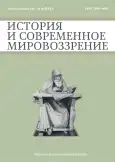К проблеме новой индустриализации и перехода к очередным технологическим укладам на Урале и сопряженных территориях. Часть 2. Советские практики
- Авторы: Литовский В.В.1
-
Учреждения:
- Институт экономики Уральского отделения Российской академии наук
- Выпуск: Том 4, № 3 (2022)
- Страницы: 26-40
- Раздел: Статьи
- URL: https://journal-vniispk.ru/2658-4654/article/view/147245
- DOI: https://doi.org/10.33693/2658-4654-2022-4-3-26-40
- ID: 147245
Цитировать
Полный текст
Аннотация
Полный текст
Открыть статью на сайте журналаОб авторах
Владимир Васильевич Литовский
Институт экономики Уральского отделения Российской академии наук
Email: vlitovskiy1@yandex.ru
доктор географических наук, заведующий сектором размещения производительных сил и территориального планирования Института экономики Екатеринбург, Российская Федерация
Список литературы
- Гаврилов Д. В. Урало-Кузбасс: грандиозный проект мирового масштаба //Урал индустриальный. Бакунинские чтения. Индустриальная модернизация Урала в XVIII-XXI вв.: Материалы ХI Всероссийской научной конференции, Екатеринбург, 26-27 сентября 2013 г. Екатеринбург: Издательство УМЦ УПИ», 2013. Т.1. С. 15-33
- Ежов А. О. Авиационная металлургия на Урале в годы Великой отечественной войны (1941-1945 гг.) //История и современное мировоззрение. 2021. Т. 3. № 1. С. 127-138.
- Ежов А. О. Титановое производство на Урале в 1950-1980-е годы /Двенадцатые Татищевские чтения: Материалы Всероссийской научно-практической конференции. Екатеринбург: Изд-во КВАДРАТ, 2020. C. 159-166.
- План электрификации РСФСР: Доклад VIII съезду Советов государственной комиссии по электрификации России. Изд. 2-е. М., 1955. С. 517-518.
- Жимерин Д. Г. История электрификации СССР. М.: Соцэкгиз, 1962. 458 с.
- Литовский В. В. Теоретико-географические основы формирования доминантного урало-арктического пространства и его инфраструктуры (для задач формирования многофункционального базисного опорного внутреннего и континентального моста России по оси «Север-Юг»). М.: ГЕОС, 2016. 398 с.
- Литовский В. В. Концепция размещения в Арктике производительных сил на базе инфраструктуры второго уровня А. Э. Юницкого и пространственная модель транспортной сети «Полярное кружево» для «мобильных поселений» // Вестник МГТУ. Труды Мурманского государственного технического университета. 2016. Т. 19. № 2. С. 431-442.
- Литовский В. В. О новом базисе естественных производительных сил и регионального развития в свете прогресса наук о Земле и разработок в сфере инновационного транспорта и инфраструктуры // Север и рынок: формирование экономического порядка, 2018. № 2(58). С. 126-137.
- Литовский В. В. Высокоскоростной надземный транспорт в освоении пространства Евразии: Уральский «крест» // Восточная аналитика. 2019. № 2. С. 60-71.
- Литовский В. В. К проблеме новой индустриализации и размещения производительных сил на основе актуализации исторического опыта и практик перехода к очередным технологическим укладам на Урале и сопряженных территориях. Ч. 1. Первичные практики // История и современное мировоззрение. 2022. №2. С. 12-19.
- Меерович М. Г. Ассимилированное производство и советская модель мобилизационного «народного» хозяйства / Мобилизационная модель экономики: исторический опыт России ХХ века: Cб. мат-лов Всерос. научной конф. Челябинск, 28-29 ноября 2009. Челябинск: ООО «Энциклопедия». 2009. С. 199-210.
- Меерович М. Г. Градостроительная политика в CCCР (1917-1929). От города-сада к ведомственному рабочему посёлку. М.: НЛО, 2017. С. 352.
- Спицин П. К. Современное состояние производства редких металлов и их аналитического контроля на предприятии «Уралредмет» // Аналитика и контроль. 1997. №2. С. 52-55.
- Тибо-Бриньоль В. О размещении новых энергетических и промышленных центров по Восточному склону Урала // Хозяйство Урала. 1930. №10. С. 71-79
- Шихалеев А. Задачи железнодорожного транспорта в связи с развертыванием Урало-Кузнецкого комбината // Хозяйство Урала. 1931. №2. С. 20-34.
- Урал. Технико-экономический сборник. Екатеринбург: Издание Областного экономического совещания, 1923. Вып.6. 502 с.
- Хозяйство Урала. 1930. №10.
- Юницкий А. Э. Струнные транспортные системы: на Земле и в космосе. Минск: Беларуская навука, 2017. 379 с.
- Ebenezer Howard. Garden Cities of To-morrow. London: Swan Sonnenschein & Co., Ltd., 1902. 167 p.
Дополнительные файлы








